SPOT Personal Tracker
The SPOT Personal Tracker has been discontinued. It was replaced by the SPOT Gen4.

I’m Lost, Help Find Me: A SPOT Gear Test
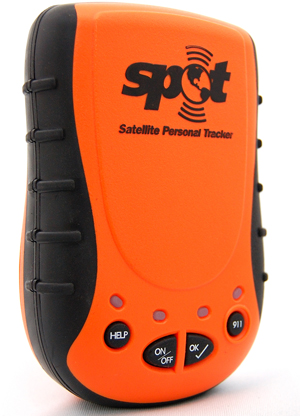
Figure 1. SPOT Satellite Messenger
Background
While it is always best to avoid getting lost or injured in the first place, an increasing number of people are heading into remote backcountry areas, some lacking in navigational and survival skills. The result is an increasing number of incidents requiring the rapid summoning of help. At the same time, the proliferation of cell phones and GPS receivers has increased dependence on electronic devices to locate lost and injured persons.
While 911 emergency systems can summon aid in urban areas, typically with a 5-minute response time, an expectation of rapid response in non-urban areas has developed. Thus the concept of a device similar to aircraft Emergency Locator Beacons (ELT), marine emergency beacons (EPIRB/Emergency Position Indication Radio Beacon), and skiers’ avalanche beacons has given rise to several types of pocket-sized personal locator and tracking devices.
The traditional locator device is a simple transmitter that is activated in an emergency situation such as a hard impact (aircraft) or immersion in salt water (marine beacons), with the option of manually activating it. In the case of avalanche beacons, the beacon is turned on at the start of a tour and left on continuously in case the wearer is caught in an avalanche. In the past, a transmission did not include any identifying or location information, and had to be found by a relatively complex search procedure. Now, many EPIRB’s for aircraft, marine, and backcountry use transmit an identification code and are located by reception by satellites. For many applications, coded EPIRB’s are required, and must be registered.
There are three types of emergency location devices available for the backcountry traveler.
TracMe
The simplest device is similar to the basic ELT or avalanche beacon, in that it transmits a simple signal that must be located by a grid search procedure. The TracMe is an example of this. It is activated by pulling the bottom off. It then transmits a signal on FRS Channel 1. The searcher has to know that the person is missing to begin the search and must have an FRS radio. The search consists of proceeding in the direction the missing person is thought to have taken, while listening to the FRS radio. The signal can be received if you are on line of sight up to 2 to 5 miles, depending on the terrain. Once the signal is acquired, you continue in the same direction until the signal peaks and starts to fade. You then turn at right angles at the peak signal point and find the next peak signal point. This type of grid search is the simplest for an untrained searcher, but can be improved by someone familiar with avalanche search procedures.
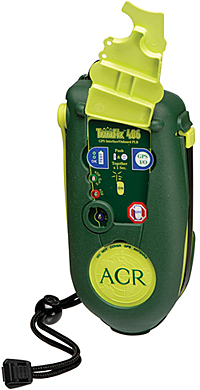
Figure 2. The ACR TerraFix 406 personal locator beacon.
The strength of the TracMe type of device is its simplicity and low cost. A young child can be trained in its use and can carry it with him or her. If she discovers she is lost, she can activate the unit and stay in one place until found. Youth organizations can equip everyone in the group with a unit, with the leaders having FRS radios to conduct a search. The weakness is that you must know that a person is missing, their general location, and that they have a TracMe.
Personal Locator Beacon (PLB)
An example of the most sophisticated Personal Locator Beacon (PLB) is the ACR TerraFix 406. Like the marine EPIRB, it transmits on 406MHz, must be registered, and is received by the COSPAR-SARSAT satellite system. It includes a GPS-derived position in its transmission, so the satellite system can get a much more accurate location than the simple triangulation used for EPIRB’s without an included GPS receiver. It is, however, quite expensive, costing typically $600-$700 (though sometimes on sale for as little as $400). Like all PLB’s, it must be activated manually.
SPOT
Recently, a much less expensive emergency beacon, known as SPOT (Satellite POsitioning and Tracking), has become available. Like the ACR TerraFix, SPOT includes a GPS receiver. However, instead of using COSPAR-SARSAT, SPOT (a subsidiary of Globalstar) transmits its messages via the digital service of the Globalstar satellite phone system.
Basic Features of SPOT
SPOT has several attractive features. First is the price ($170 plus an annual subscription, depending on how much message capability you want). Second is that you have several message types you can send out: OK, Help, and 911.
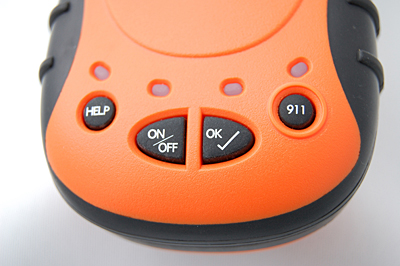
Figure 3. The SPOT Satellite Personal Tracker’s function buttons.
OK and Help
The OK and Help messages are sent to a group of up to five people you designate for each type at their email or cell phone text address. The 911 message is sent to an international search and rescue coordination agency, which then attempts a contact with your designated primary contact to confirm your registered information, then notifies the main search and rescue agency nearest your location as given by the SPOT 911 message.
The OK and Help messages are pre-programmed by the user on the SPOT website before you head into the field, along with your list of contacts for each of the two message types. For example, your OK message might be “I’m OK, but running late.” The OK message is repeated three times during a 20-minute period, to ensure that it is transmitted via the Globalstar network.
The Help message might be “I’m stranded at this location and need assistance.” These messages are transmitted at 5-minute intervals, along with the time and GPS-derived location. This information is relayed to your five Help contacts, along with a link to GoogleEarth that will display your location on a satellite image or map. This allows notification at a level that does not require a full-scale search-and-rescue effort (see the GoogleEarth image, Figure 9, below).
Track
Another type of information that can be transmitted to a designated group is the Track information. This is a simple time and location message, transmitted every 10 minutes, that is stored on the SPOT website for up to 30 days. It is accessed by someone you have supplied with your username and password, or can be shared by means of a Share message, sent to a list of recipients, that allows them to click on a link that allows display of the Track locations on a GoogleEarth map.
911
Unlike the traditional PLB, the SPOT 911 message does not activate the COSPAR-SARSAT network. Rather, the message is relayed via Globalstar to the GEOS International Emergency Response Center, repeated at 5-minute intervals until cancelled or the battery runs dead. This message includes your identification, the time of the message, and, if a GPS-derived position is available, the position. When GEOS receives the message, they attempt to contact your primary contacts to verify the information on file. GEOS then notifies the search and rescue (SAR) agency in the area of the location. If SPOT does not have a GPS lock, GEOS continues monitoring the signal and attempting to contact your primary contacts.
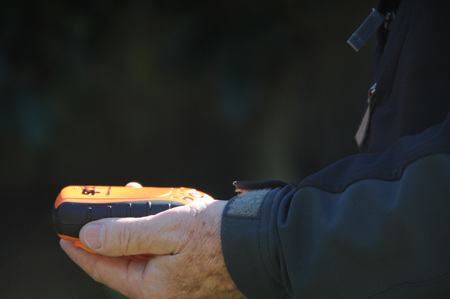
Figure 4. The author tests his SPOT device. For the best message transfer it is important to hold the SPOT horizontally. (Credit: Bill Straka)
Field Testing and Evaluation
Overall, SPOT is an excellent concept. It provides a relatively inexpensive means of summoning help in an emergency, providing approximate tracks, and sending brief status messages, while in remote locations. Operation of the device is simple, a very desirable feature for an emergency signaling device.
During my testing of SPOT over a six-month period, I put it through tests in a few simple and a number of more difficult situations. Because SPOT uses a GPS-derived position for each of the message types, I included the very trying canyon and canopy situations, including the steep canyons and redwood forests in the Santa Cruz mountains and mountainous terrain in the Sierra Nevada. Tracking tests were performed during hikes on established trails and off-trail, and on bicycle. Help messages were generated in the full range of locations and while in a snow cave. The 911 function was not tested, but is similar enough to the Help function that the results should be representative.
In the case of Help messages, I allowed the SPOT to run for an hour or two at a fixed location, then averaged the locations. Individual positions varied up to 150 feet from one another. This is due in part to the inherent random variations in positions derived from the GPS data and in part due to the “quantization” of the SPOT reports (SPOT reports longitude and latitude in decimal degrees to 4 places (0.0001 degrees), or approximately on a grid with a 36 foot spacing.
Error sources for GPS-derived positions include errors in the clocks in each satellite and in the receiver, atmospheric effects in the ionosphere and troposphere through which the signals for each satellite must pass, drift of the orbit from the most recently updated ephemeris for each satellite, and other factors. When the Help positions for durations of an hour or more were averaged, the derived location was always within 5 feet of the actual location derived from topographic maps and from positions obtained from commercial GPS receivers (including one case where a survey-grade GPS position was obtained).
The top-level conclusion is that, as an emergency locator, SPOT is adequate for most probable users. There are some limitations that can be worked around if the user will make the effort to become familiar with SPOT in benign situations before venturing into a higher risk situation. Details will be given in the following discussion.
Basic Operations
Setting up and using the SPOT is very simple out of the box, perhaps deceptively so, since getting a really useful emergency message through requires a little understanding of how the system works, from the GPS-based part of SPOT through the relaying of the messages via Globalstar to your team or GEOS. This same caution about making SPOT fully reliable applies to any emergency locator. However, the skimpy user manual and the website both are less informative than desirable, although more information has been added to the website over time.
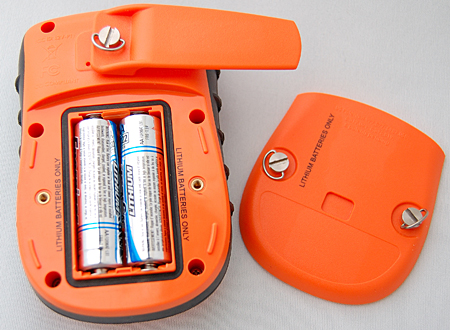
Figure 5. Step one of SPOT’s easy set-up: insert batteries.
All that is necessary to get SPOT ready for use is to remove it from the box, insert the batteries (preferably lithium-iron AA’s — alkaline batteries have a much shorter life), and setting up your profile on the SPOT website. Your profile consists of creating a message for the OK and Help functions, entering the contact information for up to five team members each for the OK and Help functions (email address or text-messaging address), and providing certain information for the 911 function. You should review and update your information for each trip, as you should do anyway in providing information to your contacts on your itinerary for each trip.
Once at the trailhead, the unit is turned on by holding the power button down for a couple seconds. An OK signal is sent by pressing the OK button and holding it for a couple of seconds. The OK and power LEDs will blink simultaneously, indicating that a 3D fix has been obtained. The unit will attempt three times during a 20-minute period to send a signal through the Globalstar satellites. When the signal is being sent, the OK light will glow steadily for a few seconds. Because relaying the signal is dependent on a Globalstar satellite being in the right position, it is best to keep the unit oriented properly in a location with a clear view of the sky for the full 20 minutes.
During my tests, I found that the message usually got through within 10 minutes if I was in a favorable location, but often did not get through if I turned the unit off in less than 10 minutes, if I were in less favorable locations or was moving, or was not careful to keep the unit properly oriented. If the unit does not have a 3D lock, the message that is transmitted includes a comment “No GPS Fix” (see example below). This message may still get through, however.
It is important to note, that while SPOT indicates that OK, Help, and 911 messages have been transmitted, there is no indication that the message has or has not been received. To be fair, the same is true of most, if not all, ELT, EPIRB, and PLB units for the non-military user.
To track your position, the OK button is held down until the OK LED shuts off, indicating that the Track mode has been entered. The power and OK lights then will blink simultaneously every few seconds as long as a 3D fix on the GPS satellites is held, but will blink at different rates when lock is lost. In the Track mode, your position is sent to your user file on the SPOT website, and to those people for whom you have created a Share notification (more about Share later).
If a situation arises in which you need to call for help, you can send a message with either the Help or 911 buttons, depending on the seriousness of the situation and/or your arrangements for a backup team. In either case, with the SPOT turned on, hold the Help or 911 button down for about 5 seconds to initiate the request. With the Help button, the message sent is the one you preprogrammed on your SPOT web page, with an attempt to send every 5 minutes, continuously until the battery runs down. This message goes to the Help team you entered before leaving on your outing.
The 911 message is sent to the GEOS international site, which attempts first to contact the primary contact you supplied. This helps to confirm that the message is real and not a false alarm (two friends who have used SPOT have accidentally triggered the 911 message during an outing). GEOS then contacts the search and rescue agency covering the area in which the signal originated. Both the Help and 911 messages can be cancelled.
The following are some typical messages that get sent to your team. Although the dates of the messages may be fairly old by the time you read this, I believe you will be able to see the GoogleEarth display if you enter the URL in your browser. Note that the messages contain a title, identifying the type of message, the serial number of the SPOT unit, the latitude and longitude (to 4 places in decimal degrees, or approximately 36 feet), a “Nearest Location” and distance to the location, the time of the transmission in Universal Time (not the local time at the location), and the URL to see the GoogleEarth display.
The “Nearest Location” often comes up as “not known”, even when in a city or other well-defined location. In a number of cases, the named location is fairly obscure or may be a significant distance away. It would seem to be of minor importance, since the lat/lon position is given to about 36 feet, a much more useful piece of information when searching for someone who is lost, especially since you can see the map and satellite image just by clicking on the URL.
Several GoogleEarth satellite images and maps from National Geographic’s Topo! with locations from SPOT tests and tracks obtained with a Garmin 60CSx are shown below.
Figure 6. Donner Pass Area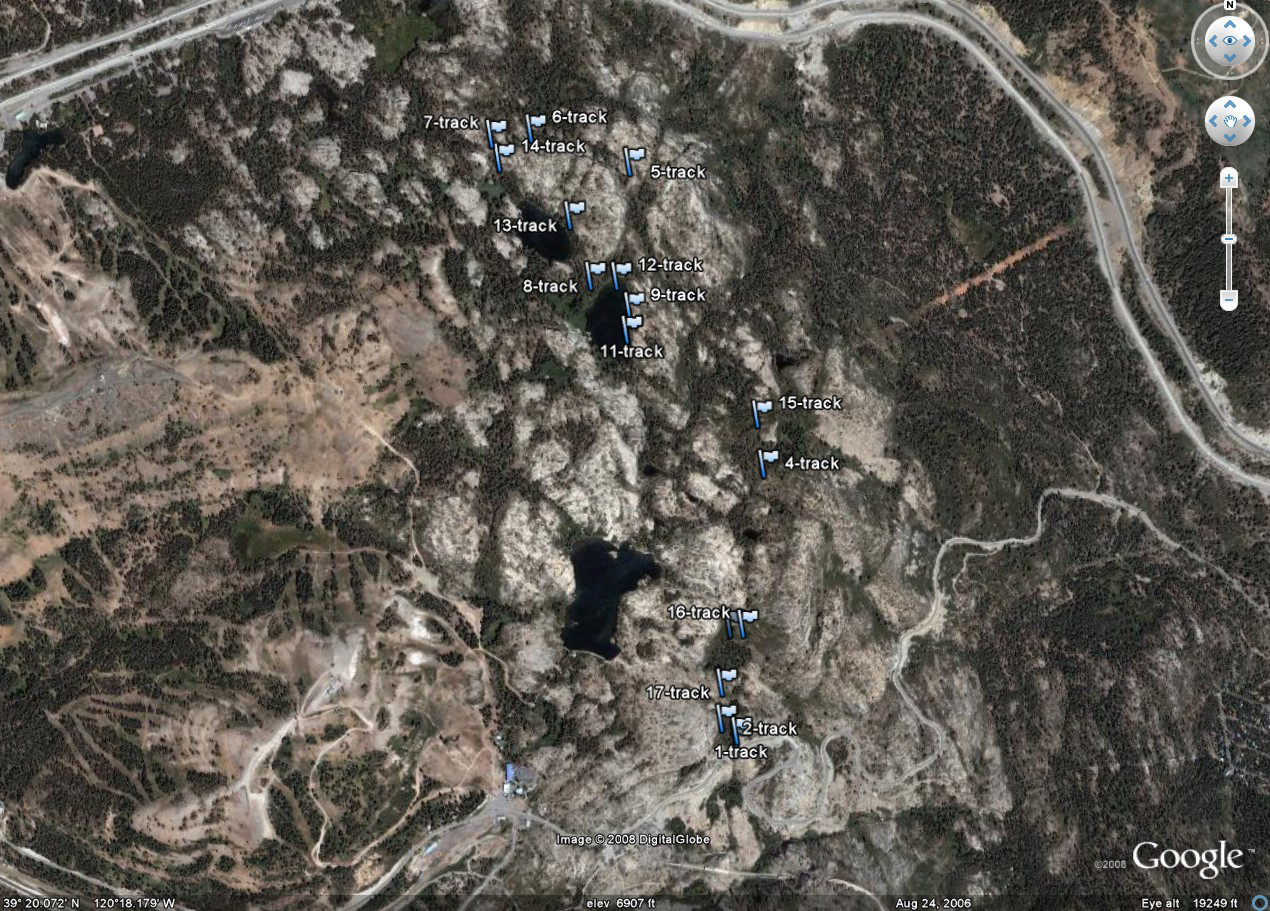
Figure 6 shows the series of Track points generated during a hike along the Pacific Crest Trail, going from Donner Pass north to Flora and Azalia Lakes and returning, as shown on a GoogleEarth satellite image. Note that the spacing between points, which are numbered in time sequence, is not uniform. This is due to dropouts in SPOT holding fixes on the GPS satellites and links to Globalstar under tree canopy and “canyon” effects. Also, since the nominal spacing of Track points is 10 minutes, the trail distance between points at a 3 mile per hour hiking rate is about one half mile. The actual spacing will vary with hiking speed, as well as the loss of satellite contact. Thus, detail of the actual path taken is lost.
Figure 7. Mission Peak, comparing GPS track with SPOT Track points
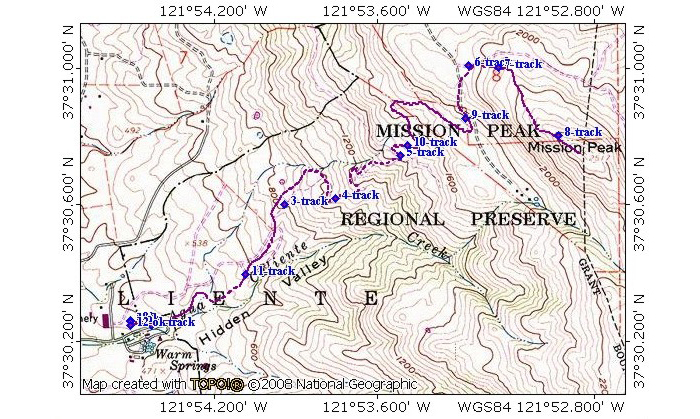
Figure 7 compares a series of SPOT Track points (blue diamonds) collected during a hike up Mission Peak, in the San Francisco Bay Area, to a track file (purple dashed line) recorded with a typical consumer GPS receiver, a Garmin 60CSx. Again, the track points are numbered in time sequence. Some Track points are not on the Garmin track, due in part to the precision of the SPOT being approximately 36 feet, in part because of the inherent error budget of the Global Positioning System, and in part due to terrain effects (“canyon” effects) on the steep hillsides.
Figure 8. OK Message, Windy Hill Open Space Preserve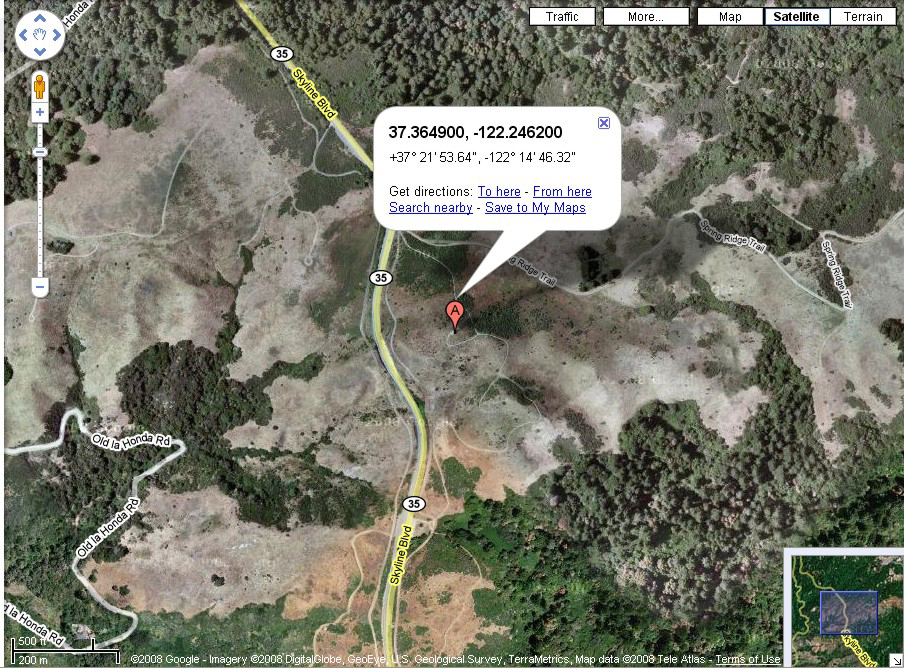
Figure 8 is a GoogleEarth satellite image produced from an OK message. The message used for the image is shown below. When your team members receive an OK or Help message, they can view the image by entering the URL contained in the last line of the message block into most web browsers. The location in this case is Windy Hill, near Skyline Drive on the San Francisco Peninsula.
OK Message
Bill S SPOT test. I'm here.
ESN:0-7361118
Latitude:37.3649
Longitude:-122.2462
Nearest Location:not known
Distance:not known
Time:08/24/2008 18:04:07 (GMT)
http://maps.google.com/maps?f=q&hl=en&geocode=&q=37.3649,-122.2462&ie=UTF8&z=12&om=1
Figure 9. SPOT Help message from inside snow cave
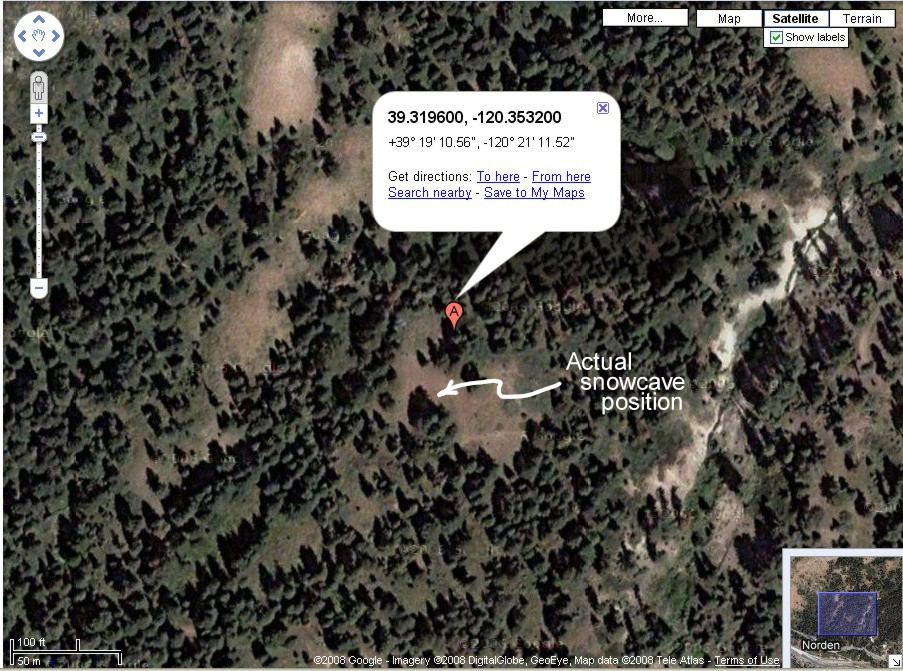
The following Help and Help Cancel messages were generated from inside a snow cave at the location marked in Figure 9 above as “Actual snowcave position.” The position given by SPOT is about 95 feet from the snow cave. GoogleEarth images are in general from snow-free days. Displacement is due to a combination of canyon and canopy effects, plus passage through the roof and walls of the cave. Note, however, that getting within 100 feet is far better accuracy than a search and rescue team is normally provided.
Help Message
This is a HELP message from Bill Straka. Testing only.
ESN:0-7361118
Latitude:39.3196
Longitude:-120.3532
Nearest Location:not known
Distance:not known
Time:03/08/2008 00:31:56 (GMT)
http://maps.google.com/maps?f=q&hl=en&geocode=&q=39.3196,-120.3532&ie=UTF8&z=12&om=1
Help Cancel Message
The help message has been cancelled
ESN:0-7361118
Latitude:No GPS fix
Longitude:No GPS fix
Nearest Location: not known
Distance: not known
Time:03/08/2008 00:38:40 (GMT)
Conclusions
As stated earlier, SPOT serves a very useful function as an emergency location device at a very reasonable price. Keeping the price down led to several compromises in the first generation of SPOT. The biggest compromise was the decision to use a combined GPS receiving and Globalstar transmitting antenna, combined in a flat plate (patch) antenna design. This combination has degraded sensitivity compared to having dedicated separate GPS and satellite communication antennas, compared to current consumer GPSR’s. This results in a significant sensitivity to orientation and to canyon and canopy effects.
The combined antenna also is weaker in getting signals through to the Globalstar satellites than a dedicated separate antenna would be. The GPS chipset was chosen for low power consumption, hence long battery life. This chipset is also less sensitive than chipsets introduced by many companies in the past couple of years.
In practice, these compromises result in skipped updates in Track messages and times when OK and Help messages do not get through. In some cases, I observed gaps of more than 30 minutes, up to over an hour in Track message sequences. This was particularly true when bicycling or hiking under redwoods, but showed up under other conifers as well. Individual positions were sometimes off by 150 feet or more, although leaving the unit stationary for extended periods (such as would normally be the case when sending genuine Help or 911 messages) allows averaging the reported positions and getting positions accurate to a few feet.
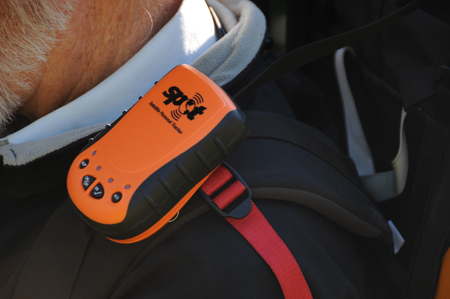
Figure 10. SPOT can be worn horizontally on a pack’s shoulder strap. (Credit: Bill Straka)
Users of the present generation can greatly improve the message transfer success rate by making sure that the SPOT is held horizontal with the SPOT logo facing directly vertically. The inclusion of a belt clip encourages users to clip the unit to the belt or a pack strap in a vertical position. If your pack has a means of clipping the SPOT horizontally on the top or if you can tape SPOT in place in a horizontal orientation (but do not use a metallized tape, such as many versions of duct tape), message transfer and GPS reception will be enhanced. As I determined this during my tests, my success rate at getting a higher percentage of Track positions, and OK and Help messages through the system improved greatly. Further, when sending OK and Help messages, I found that making an effort to get into an open area and to keep the SPOT positioned correctly for 15 to 20 minutes also enhanced the success rate.
It is important to remember that the speed of getting messages through and any actions taken as a result are dependent on the messages being monitored. SPOT’s 911 messages are continuously monitored by GEOS, and the response time is very timely for rescues in remote areas. However, OK and Help messages are sent either as email to your team members’ email system or as a text message to their cell phones. These two message types are intended for less urgent contacts. If your team members’ cell phones are turned off or if they only check their email once a day, any needed action could be long delayed. Some friends who participate in adventure races make sure that their backup team is continuously monitoring their progress.
SPOT has been in the field for more than a year. The real proof is rescues. SPOT is credited with more than 50 rescues. One unsuccessful rescue generated a lot of overly sensational press coverage. However, the 911 signal was received during a significant blizzard in the Sierra, which prevented the search and rescue group from being able to respond quickly. The body recovery was affected before the storm had completely cleared, nonetheless. The autopsy showed that the victim had probably died of hypothermia within hours of the signal being received.
There have been several false alarms, due to the 911 button being pushed accidentally. Two of these involved friends of mine, one during an adventure race and the other on Denali. The adventure race incident involved the 911 button actually being pushed by mistake. This was cancelled when the racer’s primary contact was reached at a checkpoint, at about the same time as she had passed the checkpoint.
The Denali alarm occurred because the unit was in the top pocket of the pack of one of the two in the party and was set down against a rock during a rest stop. The 911 button does have a raised ring around it. I have found in various intentionally trying scenarios that it is indeed possible to accidentally activate the unit (the 911 function was disabled in my test unit intentionally, but the other buttons are sufficiently similar). The SPOT developers are aware of this problem and are addressing it.
In discussions with the developer of SPOT, I learned that they are addressing the issues I mentioned above. In some cases, there have been significant technical advances that address the normal issues with the first generation of any device (as there are in all electronic devices, even in later generations). Other issues concerning the user interface are being addressed also. Hopefully, Trailspace will be able to test the next generation SPOT in the near future. We will update this review when the new version becomes available to us.
Some readers might infer that SPOT has too many problems in its present state. On the contrary, if the user is aware of and takes into account the basic limitations of the Global Positioning System and satellite communications systems, and indeed of all electronic positioning and communications systems, SPOT can be literally a life saver, and has been already. SPOT, like all GPS-based and satellite-communications-based systems is undergoing rapid development. In my discussions with the company, they are taking their mission of making an affordable emergency location device very seriously.
However, no matter how good and how inexpensive personal emergency location devices become, and no matter how rapidly emergency responders can get to the site of an incident, it remains the responsibility of each individual going into the outdoors to be properly equipped, properly trained, and to avoid accidents and incidents. There is risk in everything in life, and no electronic widget is going to completely remove that risk or guarantee life and limb.
Source: received for testing via the Trailspace Review Corps
(Sample provided by Spot for testing and review)
I am super pleased with this product!!
For the last 18 months the SPOT has been living in the top of my backpack. I usually hike 10-12 weeks every summer, and an occasional week-end now and then the rest of the year. I'm an epileptic, so naturally my family is a bit worried about me hiking alone. For some strange reason I'm not...
The first time I tried it I placed it on the stairs outside my house. In that way 180 degrees was covered by the house, and in front there were a lot of trees. I could hardly see the sky, but after a few minutes I received an email with a link to google maps, and it missed my exact position by about 10 meters. Pretty good if you ask me.
When I'm out hiking I send an OK message home every night when I have made camp. In the 150+ nights I've used it, it has only failed to get a message through once. I have added my own email address to the notification list, so I can check if a message has gotten though when I have mobile phone coverage. When I saw that the message had failed to get through that night I moved the SPOT a few meter and tried again, and this time it worked. Of course that one missed message could have been in a life threatening situation, but no systems are 100% perfect. I've used it both above and below the tree line.
As for the billing process, at least here in Europe we receive a notice two weeks in advance of a renewal charge, so canceling shouldn't be a problem. Never tried, so I can't be sure. An email to customer service regarding a serial number was answered in a few hours.
The web pages where you configure where to send notification to, maps and stuff like that could use a little clean up though.
There are two things I would have liked to see different though. One being able to get an indication that the message sent actually went through. The second are covers for the "help" and "911" buttons, as they are fairly easy to press by mistake. I covered mine with two washers and a bit of duct tape.
The newer model has addressed the second issue, but still no feedback signal. It has also gotten smaller and lighter, but the battery life has shortened.
Price Paid: $350
The SPOT is unique in what it does. To my knowledge, there isn't any other product that's out there that has the same price point and performs the same function. So it's hard to assign a star rating to it when the device isn't perfect.
If it works for you in your activity, in your area, you're probably going to be a happy customer. I signed up for the 2-year service, which also got me a rebate for the cost of the device itself. So I pay about $15/month for the device, tracking, and even the optional rescue service.
One thing to keep in mind is that this is a totally one-way device. The only thing that you can do with it is *send* information. You can't get *any* information on the device itself -- not your current location, messages from your contacts, or even whether it was able to send your messages successfully. It's designed to be used only as a high-tech tracking and emergency beacon.
The device is fairly simple to operate and monitor. The only downside is that there's no good way to distinguish if you're in "OK" mode or in "tracking" mode, since they show the same status. You just have to know that you initiated the mode properly. This is unfortunate, since the two modes that are hard to distinguish are the two that you're going to use the most frequently.
The biggest downside for me is that this device simply does not work well in the hills of central Pennsylvania. Unless I'm at a very high ridgetop with a 360 degree view of the horizon, no messages make it out from the device. Even moderate hills (much less valleys) obscure the signal, and none of my contacts get the signal. I suspect the satellites are very, very close to the horizon here, and are just barely visible to the device even under good circumstances.
The end result is that I get better emergency coverage with my cell phone for the areas of forest that I'm visiting most of the time.
It seems that people in other parts of the country don't have this problem. In particular, the coverage in the western United States seems excellent.
So my advice is to see if you can make sure you get good coverage in your area first. The coverage map that the company provides isn't necessarily a good indicator that you'll be able to get a satellite signal when you need it.
Price Paid: $150
This is an awesome product and I never hit the trails without it. I hike alone and spend extended period of time in the back country and this gives my wife peace of mind as well as a little extra comfort for myself.
The functions are fairly simple if you read the directions and it is accurate to within 50 feet of my actual location. I have dropped the messenger countless times on rocks and boulders and it still works great so it has good durability.
It does however take a long time to acquire a signal, up to 20 minutes at times. The only time I haven't been able to get a signal is in heavy overcast. Other than that it works in canyons, mountain valleys, light overcast, and heavy forest.
I recommend this to anyone going going into the back country.
Price Paid: $150
I have had my Spot for about a year. I do a lot of motorcycle riding in the mountains. It seems to have a really hard time getting a message out if you are not in wide open spaces.
I just went on a 7-hour motorcycle ride in the mountains, covering 150 miles. I sent 5 OK check-in messages druing the ride, and only 1 got through. Does this mean that if I crash and need help I have a 20% chance that my message will get out? What if I am too injured to climb to the top of the nearest mountain where I have unobstructed skies?
A good choice if you are in wide open spaces, but maybe not in the mountains, or the forest.
Price Paid: $99
First of all, it doesn't work unless you have wide open sky. Perhaps if you are concerned about getting lost on a prairie this product may work. I got a message out from a parking lot at a football stadium but could not get a signal from a city park with a few trees. So, if you are headed to the mountains, leave this piece of junk at home.
Second, the company will re-bill you automatically. They hide this in the fine print so you get a surprise a year later. Customer service (misnomer) is VERY RUDE and will NOT refund what they auto bill you.
This product and company are just short of fraudulent. STAY AWAY!
Price Paid: $100+
BEWARE - THIS COMPANY IS A SCAM!
Beware, SPOT is an extremely unethical company that is going to try to screw you out of every possible dollar with their shady auto-renewal and automatic credit card charges without even sending you a bill.
Two years after you thought you cancelled the device, large charges show up, and the customer service is useless and trained to make sure you pay every penny. Check out reviews on Amazon and elsewhere to see what I mean.
THIS COMPANY IS A SCAM! The outdoor community needs to spend our hard-earned money elsewhere and take this company down!
Source: bought it new
Death comes to those that are not prepared. If you want to get lost and die then do not buy. If you want your life and want your stuff then this is for you.
Pros
- It can keep you alive
Cons
- If you are cheating on whoever you could get caught
I am 78 years old and a rather disabled old lady.
I like to drive thru Death Valley and there are lots of places with no cell service. My daughter always knows how to track me and if I spend too long in any one spot she can send help. We have a two hour agreement on how long is too long.
Spot is even great in town where there is cell service.
I did a stupid procedure at the doctor's office and did not tell anyone I was going to do it. When I left the doctor's office and needed help my daughter called someone here in town and got me the help I needed.
My daughter lives 1,400 miles away from me.
Last, but not least, my car can always tell someone where it is. So far, no problems there, but one never knows.
Peace of mind and a lifeline is priceless.
News articles have told of several deaths in this area that were not needed had the people just carried a Spot with them. The deaths were in Arizona and California.
Source: bought it new
Price Paid: Do not remember. Would buy it again no matter the cost.
You've done a terrific job in your review, however, having owned a used the SPOT unit for the past 18 months let me give you the REAL skinny on this unit! The concept is great!
However, SPOT's customer service is terrible! The annual usage fee is expensive for an unreliable service. The unit has many issues. The small function lights for instance cannot be seen in daylight. The feel of the function buttons are such that you're not sure if the unit is in the proper operating mode since the feel has no response and not being able to confirm the operation mode by the lights since you cannot see them in daylight.
I'm both a pilot and ship's captain and have lent this unit to my friends who have come to the same conclusions. BUT it gets worse, the Customer Service department is near to impossible to get through to. I sent many emails never to hear back. I have made several phone calls to be put on hold for 15+ minutes causing me to hang up. I emailed and called SPOT to not renew my service and after six months past the original expiration date I am still being billed for the renewal!
I think the Customer service for this country is located outside the US and would not trust this system with my life never mind my money. For peace of mind and safety buy a REAL ELT or GPS Locator, stay away form SPOT. "SPOT, I'm still waiting to hear back from you!"
Price Paid: $149
This is an affordable, effective device for reassuring your loved ones that you're okay--or, if necessary, summoning emergency services. I'm thrilled that a consumer device like this exists for a reasonable price. My only complaints are with the interface.
The device will attempt to send an OK message for 20 minutes, and will send the message three times if possible just to make sure. During this time, the OK message light blinks and, each time the message is successfully sent, will light solidly for 2 seconds.
Sometimes I want to know whether my message was sent or not, so that I can possibly try again. But rarely do I have time to watch the device for 20 minutes to glimpse that 2-second success indicator.
I'd really like to see a "message sent/not sent" indicator that remains active until I acknowledge it. I'd also like some indication of the availability and strength of satellite signals, which would help me gauge the likelihood of a successful message or decide whether to seek out a more favorable location from which to attempt to send one.
Also, this device is significantly larger and heavier than most modern GPS receivers (I have the Garmin eTrex which seems to weigh about half as much as the SPOT).
Having said all that, I'll happily continue to use this device; I'm a female solo backpacker, and my friends and family enjoy receiving confirmation that I haven't been eaten by bears. ;) I assume the company will continue to refine its features.
Unit works...used it sailing on bluewater deliveries.
Why only 2 stars? The auto-billing policy for the services and the very un-user friendly website. I used full service at $159+/- per year. Was auto billed when annual service came up, and I had no use for service at that time. Would have non-renewed until I needed service again.
6-7 months after auto-billed, I inquired about canceling service with prorated refund, or at least to stop the auto-renewal. No luck...no refund, but could cancel and lose next 5-6 months of 'already paid coverage'. Also informed that company has no way to cancel auto renew. I have to wait until renewal date to do so, then have a 45 day grace period to cancel with full refund.
I am trying to deal with that now...and getting poor customer service...on hold on phone and auto, no reply emails stating that it may take 3 days to "respond". Also...re calls: Company is in Milpitas, CA but calls must be made during working hours for East Coast!
Re web site: For example, open my account to billing page, which allows you to 'update' credit card info....BUT NOT DELETE IT. This all reminds me of early AOL accounts.
If I needed this for USA land use only, think I would go with a Sat Phone. I might renew use of this unit...but I think I'm going to sell it or sink it!
Price Paid: $149
Decent product, crooked company.
Pros
- Can help communicate
Cons
- Crooked company
- Auto-Renewal
- Unnoticed increase in fees
Got the SPOT secondhand. Activated at about $150, which was decent. It was great to have for communicating with my wife regarding my trip status and whereabouts.
One year later, SPOT charges my CC $230 for the exact same service with absolutely no warning. Apparently, if you use their device you agree to their terms and conditions. The terms and conditions include: auto-renewal, increase in fees, no refunds, and negative credit reporting if you fail to pay.
Oh, and the way that they "notify" you of all of this is by posting to your SPOT account, as if you are constantly checking their proprietary website for these types of notices. If they sent me emails about this stuff and I neglected to respond then, sure, charge me. But the way that they sneakily do their business is enough to make a man vomit.
DO NOT BUY THIS PRODUCT. Go with one of their competitors, I hear DeLorme InReach is pretty great.
Source: bought it used
Price Paid: $150
Simply put, this dog doesn't hunt. In my tests, it failed about 90% of the time. Customer support is non-existent and the web pages are kludgey, confusing and crash-prone.
This thing is junk. Avoid it.
Price Paid: $170
i have had this SPOT for a couple of years now and I must say it gives me and my wife peace of mind. The Personal Tracker uses two Lithium batteries, wich last for about a year or more. I always replace them at the same date when the annual service renews.
Pros
- Low battery consumption
- Easy to use
Cons
- Service is 99€ per year
I use this SPOT mainly for paragliding in the Eurpoean Alps where I often fly over remote areas without cellular coverage. In case of an emergency I could alarm the rescue team and sometimes I just press the OK button and it send out a prepared text message and email to my wife. Love this thing!
Source: bought it new
Price Paid: 149
My husband got us this for extended horsepacking trips that I and my neighbor friends take. We've only used it hiking so far but it has worked very well from places we don't get cell coverage.
Your message shows up on pre-set email addresses and/or a text message on a cell phone. I think you can send your message to up to 10 addresses. There is a link in the message that plots where you are on GoogleEarth. Very, very easy to figure out!
You can send "we are ok" messages - you pre-set the message before you leave, we need help from friends, and a 911 message. The we are ok messages simply give my husband peace of mind. With the we need help from friends button you can't send a specific message but you can work out a code - for example send 5 we need help messages could translate to we need gas, 4 messages could mean we need food. 911 messages are simply a message to 911 operators showing your location but not what is wrong. Don't press 911 unless you really need it!
Price Paid: present
15,000 miles, 31 countries, and the Spot Tracker performed really well. From remote areas to urban concrete jungles it never failed me.
Pros
- Live web page
- Support services
- Affordabilty
Cons
- Battery life
I used the Tracker on a recent trip so that people could follow live via the Tracker's webpage. 15,000 miles, 31 countries in 21 days and it performed very well.
The only issues I had were batteries as I didn't have the space to carry supplies. I had no dead spots and the customized messages came in handy to let people know I was OK.
Source: bought it new
Price Paid: £120
Shoddy business practices. Lousy customer service. Largely inclined to bilk customers out of $50 purchase rebate coupon. Reputation for charging credit card for annual renewal without first querying customer if they want to renew.
Pros
- Maybe it works
Cons
- Shoddy business practices
- Cumbersome interface
- Exagerated claims of grandiose rescue
Source: bought it new
Price Paid: $121
I hike, bike, and ride motorcycles often. This has been a great addition just in case something goes wrong. Originally I bought it for personal safety, but it has also provided an unintended benefit for family and friends who can track my progress.
I ordered one from http://www.MyLiveTracks.com/ - got a prompt response to my inquiries, a 50% off coupon for the tracking service. The price of $135 included shipping as well. Highly recommend the unit as well as the vendor!
Price Paid: $135
This company sucks. I have lost two trackers and they cannot trace them. Imagine that, a tracker that you cannot track
Background
This company sucks. I have lost two trackers and they cannot trace them.
Imagine that, a tracker that you cannot track. Don't give them your money.
Source: bought it new
Your Review
You May Like
Specs
| Price |
Historic Range: $0.03-$170.00 Reviewers Paid: $99.00-$350.00 |







